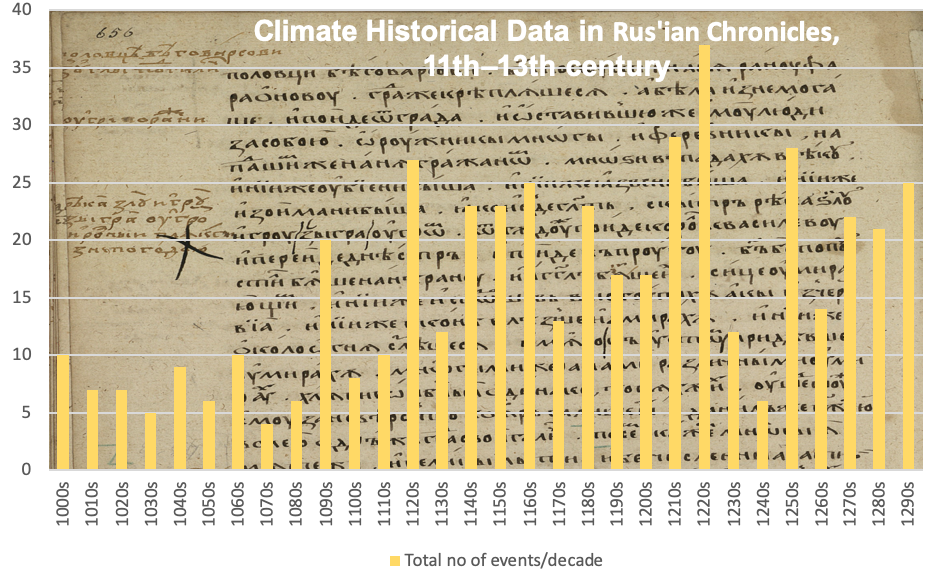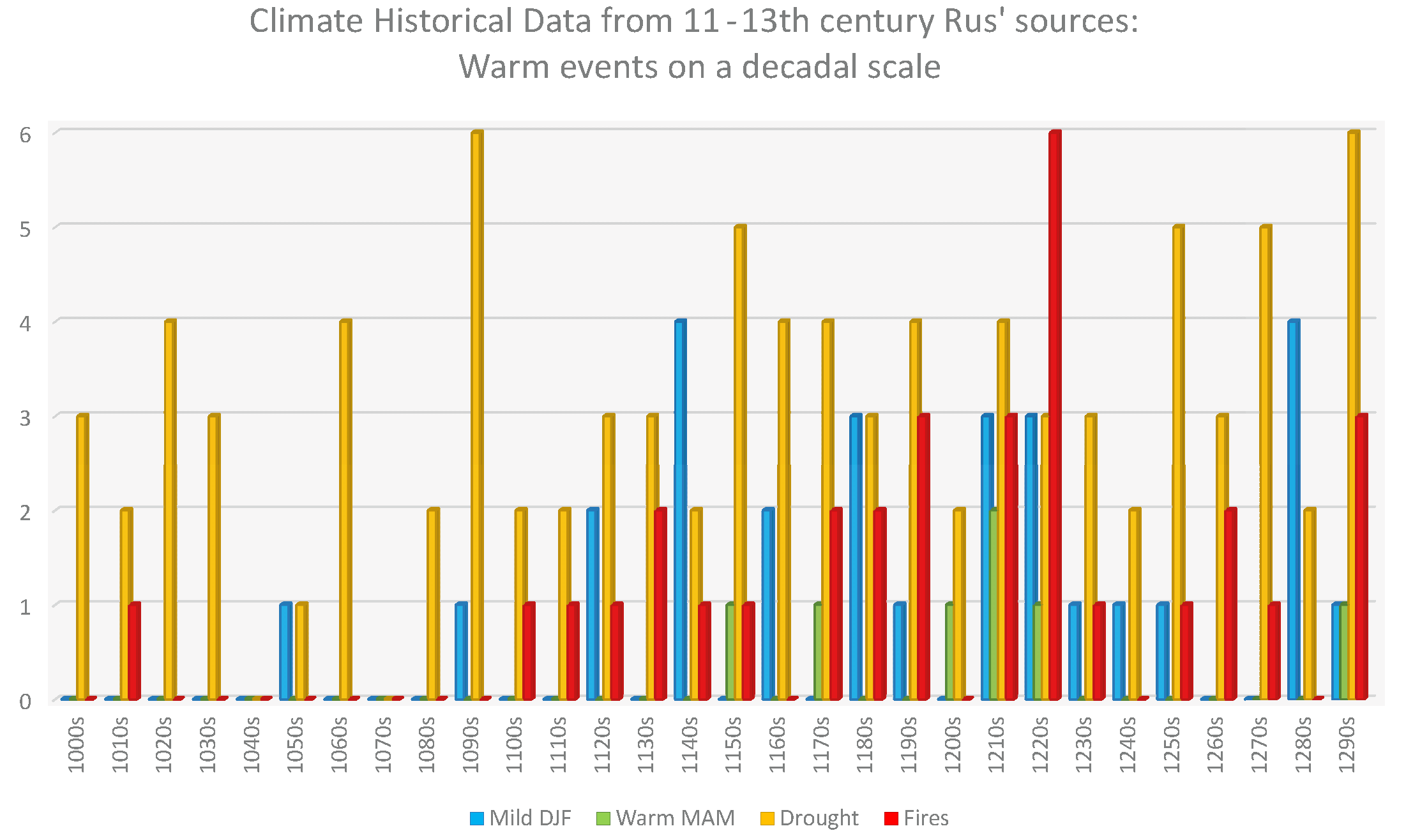- Home
- Publications
- PAGES Magazine
- Surprising Eastern Perspectives: Historical Climatology and Rus'ian Narrative Sources
Surprising eastern perspectives: Historical climatology and Rus'ian narrative sources
Jusupović A & Bauch M
Past Global Changes Magazine
28(2)
48-49
2020
Adrian Jusupović1 and Martin Bauch2
Narrative sources of the medieval period from the historic lands of the Rus’ principalities, which include parts of modern-day Russia, Ukraine, Belarus, and Eastern Poland, provide a trove of historical weather information. The long tradition of Russian climate historical research is rather unknown outside of this region.
From the 12th to the 16th centuries, the Kievan Rus' (existing from the 9th century) consisted of self-governing principalities ruled by descendants of the Rurikid dynasty and is considered the historical precursor to modern-day Russia, Ukraine, and Belarus. While academic scholarship has paid considerable attention to the ethnic origins (Norse and/or Slavic) of their elite groups, the potential of Rus'ian historiography for the reconstruction of climatic conditions of the High Middle Ages in Eastern Europe has been largely ignored outside Russia. This article focuses on climate history but aims to shed more light on this historical period and region as well.
Medieval Rus'ian narrative sources
Beginning in the mid-10th century, Rus'ian chroniclers recorded information about weather and natural extreme events, many of which they witnessed firsthand. The scriptoria functioned next to the episcopates. In the 12th century, chronicling started to become a more common practice not only in Kiev and Novgorod but also in the self-governing principalities (e.g. the city of Vladimir, today 200 km east of Moscow).
The following excerpt about a severe winter in January 1287 from the Chronicle of Halych-Volhynia serves as an example of the kind of information on meteorological conditions included in these sources: "[The Tatars] remained in Lev's principality for two weeks, living off the fat of the land. They did not engage in open warfare, but neither did they let anyone leave the city for food. [Of those that dared] leave the city, they would kill some, capture others, and rob [still] others, [releasing] them stark naked [to die] from the cold, because there was a very severe winter [that year]" (Perfecky 1973, p. 97). The Rus' sources do not only provide information about their own territory, but also report on unusual weather events from other parts of Europe, such as the St. Lucia's Day flood along the North Sea coast on 14 December the same year: "[It was rumored] that in the land of the Germans the sea overflowed its bank and inundated the country because of God's wrath. More than sixty thousand people drowned and one hundred and eleven stone churches were inundated, not counting those made of wood" (Perfecky 1973, p. 98).
Historiography of Russian climate history
In the latter half of the 1700s, scholars at the St. Petersburg Academy of Sciences began analyzing the wealth of climatic information recorded over centuries in Russian sources. In the first decades of the 19th century, Russian researchers were preparing statistical summaries about Russian climate from 147 temperature measurement sites throughout Russia. Konstantin Veselovskij collected this data and compared it with historical information extracted from different types of sources, going back as far as the era of Herodotus up to his contemporary age (1857; Zhogova 2013). Mikhail Bogolepov continued this pioneer work in climate history around the turn of the 12th century by collecting and analyzing information from published Cyrillic and Latin sources dating from the 10th century onwards (Bogolepov 1907; 1908). This body of Russian scholarship on climate history includes studies about anomalous weather (e.g. Borisenkov and Paseckij 1983; Borisenkov 1988); reconstructions showing fluctuations in Russian climate (e.g. Liakhov 1984; Borisenkov 1988; Klimanov et al. 1995; Klimenko et al. 2001; Slepcov and Klimenko 2005; Klimenko and Solomina 2010); fluctuations in river levels (Oppokov 1933); and famine years in Russia (Bozherianov 1907). The available information dates as far back as the early 11th century (see Fig. 1), though there is a significant drop in documentation in the 1230s and 1240s, likely due to the Mongol invasion of Rus' principalities in 1237.
Methodological approaches and difficulties in Russian climate history
While the source density of meteorological information from Rus' sources is considerable, most of the research does not use the original editions or appraise them critically. Instead, modern scholars have relied for the most part on Evgenij Borisenkov and Vasilij Paseckij's quantitative evaluation (1983), which incorporates only some of the available sources. The most important collection of Russian narrative sources is what is known as the ПСРЛ [Complete Collection of Rus'ian Chronicles]. Spanning 43 published volumes, these chronicles report on events such as insect infestations, droughts, unusually wet summers and autumns, early and late frosts, famines, floods, and storms. When Borisenkov and Paseckij compiled their statistics (which also includes data from Western Europe, i.e. from England, France, Germany, and the Netherlands), only 37 volumes of the ПСРЛ had been published; furthermore, Borisenkov and Paseckij frequently referred to later literary mentions rather than the original sources. It is thus not clear how they defined a drought, in which seasons it occurred, and which regions were affected (Fig. 2).
As a result, this study, as valuable as it is as the backbone of all reconstructions from documentary data in pre-modern Russia and a pioneering work, should be used with extreme caution. Borisenkov and Paseckij tried to reconstruct the Russian climate over the course of the last 1000 years, albeit with a descriptive approach rather than by applying quantitative methods such as climate indices. The existing historiography on the written sources published thus far for the territory of modern Russia must accordingly be deemed patchy and insufficiently analytical, and none of these studies incorporates the quantitative approaches established in climate history, nor do they meet the basic requirements of modern historical scholarship with regard to source criticism. In the last few years the approach to reconstructing Russian climate has changed, as researchers have looked beyond historical sources and included tree-ring reconstructions, palynological data, lake sediment records, and biostratigraphic analyses (e.g. Klimenko and Solomina 2010; Klimenko 2016).
Objectives for the near future
Closer collaboration between climate historians and specialists on early Russian narrative sources would provide a critical, up-to-date catalog of extreme events and weather-related information, not only from Rus'ian chronicles, but for the whole territory of modern-day Russia and its immediate neighbors in Eastern Europe and Central Asia. Careful English translations of original sources would allow the international community of historical climatologists to work with documentary data of Rus' and Russian origin, which could later become part of established databases such as www.tambora.org or www.euroclimhist.unibe.ch. Such an endeavor would fill the geographical gap between the dense repositories of climate-historical information for the countries of Western and Central Europe and the rich compendia organized by Chinese scholars.
affiliations
1Institute of History, Polish Academy of Sciences, Warsaw, Poland
2Leibniz Institute for the History and Culture of Eastern Europe, Leipzig, Germany
contact
Adrian Jusupović: ajusupovic ihpan.edu.pl
ihpan.edu.pl
references
Bogolepov MA (1907) Землеведение 14: 58-162
Bogolepov MA (1908) Землеведение 15: 41-58
Bozherianov IN (1907) Starving of the Russian nations from 1024 to year 1906. Gannibal, 32 pp
Klimanov VA et al. (1995) Известия Российской Академии Наук. Серия географическая 1: 89-96
Klimenko V (2016) Holocene 26(3): 365-379
Klimenko V et al. (2001) Доклады Российской Академии Наук 376: 679-683
Klimenko V, Solomina O (2010) In: Przybylak R et al. (Eds) The Polish Climate in the European Context. An Historical Overview. Springer, 71-102
Liakhov МЕ (1984) Известия Академии Наук СССР. Серия географическая 6: 68-74
Oppokov EV (1933) Research of rivers of the USSR 4
Slepcov AM, Klimenko VV (2005) История и современность 1: 118-137
Zhogova ML (2013) Естественные науки. История естествознания 1: 160-167


